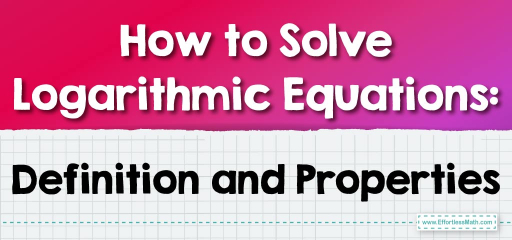How to Solve Logarithmic Equations: Definition and Properties
In the vast realm of mathematical functions, logarithmic functions stand as a cornerstone concept, especially in fields such as algebra, calculus, and real-world applications like physics and engineering. At its core, a logarithmic function acts as the inverse of an exponential function, bridging the gap between exponential growth or decay and the powers or exponents that cause such behavior. As we dive deeper into this article, we'll uncover the nuances of logarithmic functions, their properties, and their significance in various mathematical and practical contexts. Whether you're encountering these functions for the first time or seeking a refresher, this guide aims to provide a comprehensive understanding of the logarithmic world.

Step-by-step Guide to Solve Logarithmic Equations
Here is a step-by-step guide to solving logarithmic equations:
Step 1: Understand the Basics
- Logarithmic Function: A logarithm is the inverse of an exponential function. It tells us the power to which a base number must be raised to obtain another number. The logarithm of a number \(b\) to the base \(a\) is denoted as \(log_a\left(b\right)\) and is equivalent to the statement \(a^{log_a\left(b\right)}=b\).
For instance, \(log _2\left(8\right)=3\) because \(2^3=8\).
Step 2: Familiarize Yourself with the Properties of Logarithms
Before attempting to solve logarithmic equations, it’s crucial to be well-versed in logarithm properties:
- Product Rule: \(log _b\left(m×n\right)\)\(=\)\(log _b\left(m\right)\)\(+\)\(log _b\left(n\right)\)
- Quotient Rule: \(log _b\left(\frac{m}{n}\right)\)\(=\)\(log _b\left(m\right)\)\(-\)\(log _b\left(n\right)\)
- Power Rule: \(log _b\left(m^{n}\right)\)\(=n \ ×\) \(log _b\left(m\right)\)
- Change of Base Rule: \(log_b\left(a\right)\) \(=\)\(\frac{log_c\left(a\right)}{log_c\left(b\right)}\) for any positive value of \(c\), where \(c≠1\).
Step 3: Rewrite in Exponential Form
If you are given a logarithmic equation and you’re not sure how to proceed, first try expressing it in its equivalent exponential form. This transformation often simplifies the equation or provides a clearer perspective.
Example: For the equation \(log_2\left(x\right)=3\), in exponential form, it becomes \(2^3=x\), which implies \(x=8\).
Step 4: Use Properties to Simplify
When faced with multiple logarithms in an equation, use the properties of logarithms to combine or simplify them.
Example: To solve \(log(x)+log(3x)=2\), using the product rule, it becomes \(log(3x^2)=2\).
Step 5: Solve for the Variable
Once the equation is simplified, either convert the equation into an exponential form to solve directly or use other algebraic methods.
Continuing our example: From \(log(3x^2)=2\) with the base \(10\) implied, We get \(3x^2=10^2\), which is \(3x^2=100\). Solve this quadratic equation to get values of \(x\).
Step 6: Check the Domain
Remember that you can only take the logarithm of a positive number. Always check the domain to ensure the solutions are valid.
Using our example, if you find a negative value for \(x\), it would be extraneous since the logarithm of a negative number is undefined.
Step 7: Verify Your Solution
Plug the obtained solution back into the original logarithmic equation to ensure it holds true.
Step 8: Understand the Graphical Implications
Understanding the graph of logarithmic functions can provide visual insights:
- The graph of a basic logarithmic function \(y=\)\(log_b\left(x\right)\) is a curve that increases slowly, passing through \((1,0)\).
- Logarithmic functions will always have a vertical asymptote at \(x=0\) since the logarithm of \(0\) is undefined.
You’ll be better equipped to tackle and solve logarithmic equations by understanding these steps and properties. As with all mathematical techniques, practice is key. Engage in various problems to hone your skills and deepen your comprehension.
Examples:
Example 1:
Evaluate: \(log_2\left(8\right)\)
Solution:
The logarithmic expression asks the following question: “To what power must \(2\) be raised to get \(8\)?”
Since \(2^3=8\), the value for which this is true is \(3\).
Thus, \(log_2\left(8\right)\)\(=3\).
Example 2:
Simplify the expression: \(log _5\left({25}\right)\)\(-\)\(log _5\left(5\right)\)
Solution:
To simplify this, we’ll utilize the properties of logarithms, specifically the Quotient Rule which states:
\(log _b\left(\frac{m}{n}\right)\)\(=\)\(log _b\left(m\right)\)\(-\)\(log _b\left(n\right)\)
Applying the Quotient Rule to our expression: \(log _5\left({25}\right)\)\(-\)\(log _5\left(5\right)\)\(=log _b\left(\frac{25}{5}\right)\)
This simplifies to: \(log _5\left(5\right)\)
Given that the logarithm asks, “To what power must the base (in this case, \(5\)) be raised to obtain the number?”, and since \(5^1=5\), the answer is \(1\).
Thus, the simplified expression is: \(log _5\left(5\right)=1\)
Related to This Article
More math articles
- How to ACE the SAT Math?
- Which Test Is Better for You; GED, TASC, or HiSET? Find Out Now
- How to Find the y-Intercept of a Line?
- Top 10 Tips to Create the HSPT Math Study Plan
- How to Find Complementary and Supplementary Angles? (+FREE Worksheet!)
- Full-Length 8th Grade FSA Math Practice Test-Answers and Explanations
- A Comprehensive Guide to the Properties of Rhombuses
- 7th Grade WVGSA Math Worksheets: FREE & Printable
- Top 10 3rd Grade Common Core Math Practice Questions
- The Ultimate ASTB Math Course (+FREE Worksheets & Tests)





















What people say about "How to Solve Logarithmic Equations: Definition and Properties - Effortless Math: We Help Students Learn to LOVE Mathematics"?
No one replied yet.